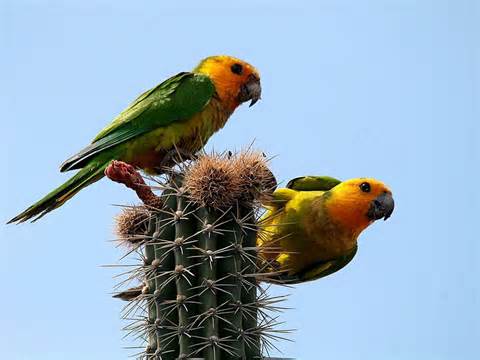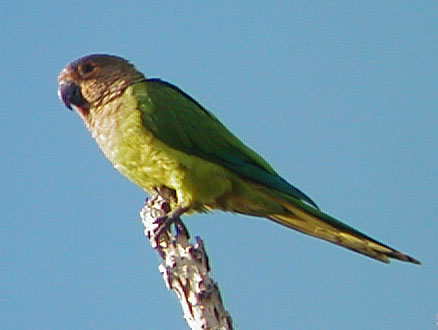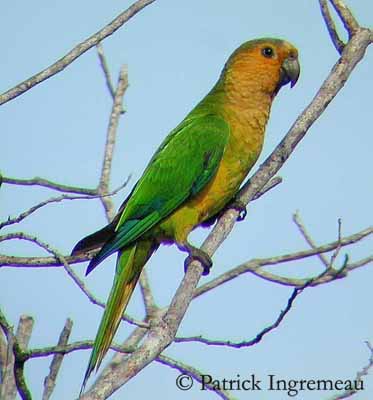
Aratinga pertinax
SUBFAMILY
Psittacinae
TAXONOMY
Psittacus pertinax Linnaeus, 1758, Curaзao. Fourteen subspecies.
OTHER COMMON NAMES
English: Brown-throated conure, St. Thomas conure; French:
Conure cuivrйe; German: Braunwangensittich; Spanish:
Aratinga Pertinaz.
PHYSICAL CHARACTERISTICS
10 in (25 cm); 2.6–3.6 oz (75–102 g). Polytypic species with
much geographical variation in extent of yellow on face and
brown on throat.
DISTRIBUTION
A. p. pertinax: Curaзao, Netherlands Antilles; successfully introduced
to St. Thomas, Virgin Islands. A. p. xanthogenia: Bonaire,
Netherlands Antilles. A. p. arubensis: Aruba, Netherlands Antilles.
A. p. aeruginosa: north Colombia and northwest Venezuela.
A. p. griseipecta: Sinъ River valley, northeast Colombia. A. p. lehmanni:
east Colombia and possibly westernmost Venezuela. A. p.
tortugensis: Tortuga Island, Venezuela. A. p. margaritensis: Margarita
Island, Venezuela. A. p. venezuelae: much of Venezuela.
A. p. chrysophrys: southeast Venezuela and neighboring northern
Brazil. A. p. surinama: Guianas and neighboring northeast
Venezuela. A. p. chrysogenys: Rio Negro region, and possibly on
Rio Solimхes, northwest Brazil. A. p. paraensis: Rio Tapajуs and
Rio Cururu, north-central Brazil. A. p. ocularis: Panama.
HABITAT
Lowlands and less commonly foothills; principally natural savannas
and deciduous woodlands, but present in wide variety of
open habitats from arid scrublands to plantations and cultivation;
avoids dense forest, so
DISTRIBUTION
patchy.
BEHAVIOR
Sedentary, though local wandering and some seasonal movements
in search of food. Generally in pairs or small parties, but
large flocks attracted to concentrated food source; noisy, especially
during swift, erratic flight with constant direction
change; often calls from conspicuous perch atop emergent leafless
branch of dead or deciduous tree; in late evening flies
about, screeching almost incessantly before retreating to nighttime
roost; tame where not persecuted, often present in or
around towns and villages.
FEEDING ECOLOGY AND DIET
Seeds, nuts, fruits, berries, flowers, and probably insect larvae
taken in trees and bushes; at study site in Venezuela up to 70%
of food plants was taken from human cultivation; causes damage
to maize crops and in orchards.
REPRODUCTIVE BIOLOGY
Monogamous. Breeding season variable throughout extensive
range, and nesting recorded in almost all months, possibly influenced
by rainfall. Nest normally in hole excavated by birds
in arboreal termitarium, but also in holes in trees, in crevices
in rocks or wall of buildings, and in burrows excavated in earth
banks; four or five nest-holes excavated in same decayed tree
trunk; clutch of two to seven, usually four to five eggs; in captivity
incubation of 23 days, probably only by female; young
birds vacated nest about 40 days after hatching.
CONSERVATION STATUS
Generally common, locally abundant; often most numerous
parrot in district. Probably benefits from landclearing and cultivation,
so range may be expanding. Listed on CITES Appendix
II.
SIGNIFICANCE TO HUMANS
Considered pest in orchards and croplands, so locally persecuted;
not popular as cagebird.
Photo Gallery of - Brown-throated parakeet




 Animalia Life
Animalia Life